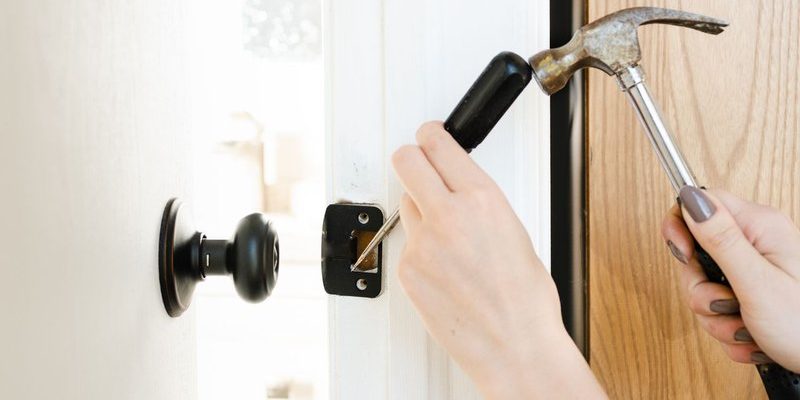
Picture this: your door is like a puzzle piece that’s meant to fit perfectly into its frame. If the strike plate—where the latch connects—is out of alignment, the door can’t fit snugly. So, let’s dive deep into the nuts and bolts of how to fix this problem yourself. Just like tuning up a bike or reorganizing a cluttered closet, a little effort can go a long way.
Understanding The Door Strike Plate
First off, let’s clarify what we mean by a strike plate. It’s a small metal plate mounted on the door frame, with a hole for the latch to slide into when you close the door. Think of it as the anchor that holds everything in place. When it’s out of alignment—maybe from shifting wood, temperature changes, or just everyday wear and tear—the latch doesn’t connect properly. This misalignment can lead to frustration and security issues.
You might be thinking, “Why does it matter?” Well, a misaligned strike plate can lead to your door not closing completely or even becoming jammed. This might let in drafts, noise, or unwanted pests. Also, an improperly secured door can compromise your home’s security. So, aligning that strike plate doesn’t just improve convenience; it’s essential for your peace of mind.
Tools Needed for the Job
Before you dive into the realignment, let’s gather what you’ll need. It doesn’t require a fancy toolbox—just some basic tools. Here’s what you should have on hand:
- Screwdriver: A flathead or Phillips, depending on your screws.
- Drill: Optional, but helpful if you need new screw holes.
- Measuring tape: To ensure everything is aligned perfectly.
- Chisel: For adjusting the strike plate hole, if necessary.
- Pencil: To mark your spots before drilling.
Having these tools ready will make the process smoother. You might even feel a bit like a DIY hero, ready to tackle home repairs with confidence!
Identifying Misalignment
Now that you have your tools, it’s time to assess the situation. Start by shutting the door and examining where the latch meets the strike plate. You might notice gaps, or you might hear crunching sounds if the latch is hitting the strike plate awkwardly.
Here’s what to look for:
– Gap Analysis: Is there a visible gap where the latch isn’t fitting into the strike plate? This can indicate whether you need to move the plate up or down.
– Latch Test: Try locking the door. Does it feel sticky or hard to turn? A misalignment often makes it harder to engage the latch.
– Visual Inspection: Look at the strike plate itself. Is it firmly attached? Sometimes, loose screws can contribute to shifting.
Once you’ve identified the issues, you’ll know what adjustments to make.
Adjusting the Strike Plate
With your tools in hand and the problem identified, let’s dive into adjusting that strike plate. This part can be straightforward, but it requires a little finesse.
1. Loosen the Screws: Use your screwdriver to loosen, but not completely remove, the screws holding the strike plate in place. This gives you the flexibility to shift the plate around.
2. Shift as Needed: Gently move the strike plate up or down to align with the latch. Keep in mind the ideal height for the latch to easily slip into the plate.
3. Tighten the Screws: Once the strike plate looks good, tighten the screws back in. Make sure everything is snug but be careful not to strip the screws.
Don’t forget to test it out! Close the door and see if the latch fits in smoothly. If it works, you’ve nailed it! If not, don’t worry—time for another adjustment.
Making Holes Bigger or Replacing the Strike Plate
Sometimes, realigning isn’t enough. If the latch simply won’t fit, you may need to enlarge the hole in the strike plate or even replace it entirely. Here’s how to go about it:
– Using a Chisel: If the hole needs enlarging, a chisel can help you carefully widen it. Be sure to wear safety goggles to protect your eyes. Carefully chip away until the latch fits snugly.
– Replacing the Strike Plate: If the plate is damaged or too far off, consider replacing it. You can find a similar or slightly adjustable strike plate at any hardware store. Follow the same installation steps to attach the new plate.
Remember, it’s important to maintain home security, so never skip this step if you feel it necessary.
Common Mistakes to Avoid
When taking on this home improvement task, there are a few common pitfalls to watch out for. Here are some mistakes to avoid:
– Over-Tightening Screws: This might seem tempting, but it can strip the screws and cause more issues.
– Not Testing Enough: After adjusting, always close the door multiple times to ensure the latch works smoothly.
– Skipping Measurements: Trust your eye too much? Take accurate measurements, so you don’t end up misaligning it again.
It’s easy to get frustrated with these details, but they’re what keeps your door working well!
Preventing Future Misalignment
Now that you’ve realigned the strike plate, let’s keep it that way! Preventing future misalignment saves you time and hassle down the road.
1. Regularly Check Alignment: Set a reminder every few months to check and ensure everything is still aligned.
2. Avoid Excessive Force: Be gentle when closing your door. Slamming it can cause misalignment over time.
3. Adjust in Changing Seasons: Extreme weather can cause wood to expand or contract. Stay vigilant during seasonal changes.
By following these tips, you can help ensure that your door remains functional and secure for years to come.
After all that work, you’ve not only fixed a small annoyance but also boosted your home’s security. It’s a win-win! A little realignment can make your space feel more stable and at ease. If you can tackle this task, think about what else you can fix around your home!
